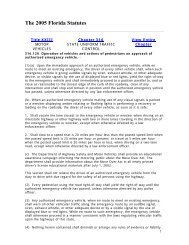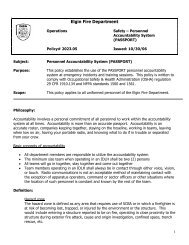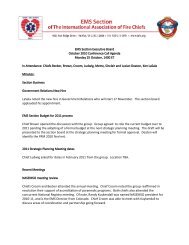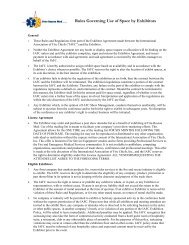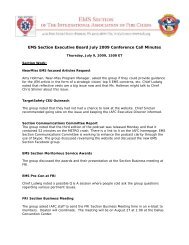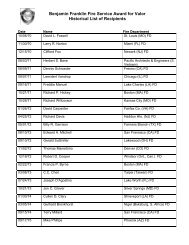Dealing with Difficult People
Dealing with Difficult People
Dealing with Difficult People
Create successful ePaper yourself
Turn your PDF publications into a flip-book with our unique Google optimized e-Paper software.
<strong>Dealing</strong> <strong>with</strong> <strong>Difficult</strong> <strong>People</strong><br />
Why Be difficult when <strong>with</strong> just a little bit of<br />
effort, you can be impossible!
Conflict<br />
• Conflict is inevitable in the workplace. However, that<br />
does not mean that we cannot work to prevent<br />
unproductive behavior that leads to conflict. <strong>Difficult</strong><br />
behavior is a good example of an area where a<br />
difference can be made. Although it is easy to label<br />
people as difficult, the real focus should always be on<br />
the actual behavior. <strong>Dealing</strong> effectively <strong>with</strong> difficult<br />
behavior is a skill that can nip conflict in the bud.
<strong>Difficult</strong> Behavior<br />
• <strong>Difficult</strong> behavior takes many forms. It<br />
includes gossiping, going over your bosses<br />
head, foot dragging, ignoring orders, refusing<br />
to talk, being rude, yelling, ignoring, harassing,<br />
and much more.
<strong>Difficult</strong> Behavior<br />
• At the core, most conflict is about needs that<br />
have not been satisfied-not just physical<br />
needs, but also psychological and procedural<br />
needs. <strong>Difficult</strong> behavior is often a result of<br />
psychological needs for control, recognition,<br />
affection, and respect.
How to Deal <strong>with</strong> the Behavior<br />
1. Stay centered<br />
• When we loose our self-control and restraint the situation does not<br />
improve. In fact it is more likely to get worse. Decisions made in the heat<br />
of the moment are seldom the best, and lack the benefits of our<br />
creativity. Our challenge is to slow down, and resist a knee jerk reaction.<br />
Staying steady, stable and grounded gives us the strong foundation we<br />
need to take on the most difficult behavior.<br />
• When we indulge ourselves by taking it personally (forgetting that offense<br />
is 10% given and 90% taken) we start playing negative internal tapes in<br />
our head. We tell ourselves that the person is bad, unreliable, beyond<br />
reason. The danger is that these labels become self-fulfilling, and do not<br />
give any benefit of the doubt. Rather than putting our energy into<br />
problem solving we feel smug blaming the other. We forget that it takes<br />
two to make things worse.
How to Deal <strong>with</strong> the Behavior<br />
2. Reality check<br />
• An important question to consider as soon as<br />
possible is whether the behavior is really causing<br />
performance problems. If it is not, and left alone<br />
things will not get worse, then leaving things often<br />
makes sense. As we reality check, it is important to<br />
consider the impact of the behavior on others and<br />
not just ourselves.
How to Deal <strong>with</strong> the Behavior<br />
3. Focus on behavior<br />
• This is the key to dealing <strong>with</strong> difficult behavior. As<br />
tempting as it is to focus on the person this should<br />
be avoided. By separating the person from the<br />
behavior it enables one-to paraphrase Fisher, Ury<br />
and Patton in their best seller “Getting to Yes” -to be<br />
hard on the problem and soft on the person.
How to Deal <strong>with</strong> the Behavior<br />
4. Listen<br />
• Listening is widely acknowledged as a core<br />
communication skill that affects the ways we prevent<br />
and resolve conflict. When dealing <strong>with</strong> people<br />
whose behavior is getting to us we should make a<br />
special effort to hear the other person out. Even<br />
when you disagree! This enables you to validate the<br />
psychological needs of the other, and to let them<br />
know that you can imagine how they are feeling.
How to Deal <strong>with</strong> the Behavior<br />
5. Give feedback<br />
• A common problem <strong>with</strong> difficult behavior is that the person<br />
is unaware that his or her behavior is causing a problem. At<br />
other times the extent of the impact is not comprehended. By<br />
giving timely feedback about specific behavior<br />
misunderstanding can be avoided and expectations clarified.<br />
A useful formula for giving feedback that deals <strong>with</strong> both<br />
emotions and facts, is the “I-Statement.” I feel frustrated<br />
when you interrupt me at our team meetings. It breaks my<br />
train of thought and I struggle getting started again. I would<br />
appreciate it if I could finish <strong>with</strong> what I am saying.”
Three Choices to Deal <strong>with</strong> <strong>Difficult</strong><br />
Managers and Co-workers<br />
• Confront the <strong>Difficult</strong> Person<br />
• Cope <strong>with</strong> the <strong>Difficult</strong> Person<br />
• Get Away (Leave) from the <strong>Difficult</strong> Person
Coping <strong>with</strong> <strong>Difficult</strong> Situations<br />
• Assess the Situation- Am I dealing <strong>with</strong> a<br />
difficult person or a difficult situation?<br />
• What am I willing to accept about this person<br />
or situation?<br />
• Should I put some distance between me and<br />
the person or situation?
Strategy to Cope <strong>with</strong> All Types<br />
• Major Strategy- Bring Issues and Problems Out in<br />
the Open.<br />
• Do not Believe that Ignoring these Issues and<br />
Problems will make them go away.<br />
• Recognize the Difference Between a <strong>Difficult</strong><br />
Person and a <strong>Difficult</strong> Work Situation<br />
• Find an Anchor for Your Own Sanity
• The reality is that we can all be difficult from<br />
time to time. <strong>Dealing</strong> <strong>with</strong> difficult behavior is<br />
not easy and so we often procrastinate. We do<br />
so at our own peril. Being proactive and<br />
engaging the person in a conversation about<br />
their behavior is the first step toward conflict<br />
prevention.
Exercise<br />
1.List one behavior that you find difficult to<br />
manage<br />
2.What is the result of managing the<br />
behavior?<br />
3.How does the difficult behavior impact<br />
your ability to manage?
Re: Understanding <strong>Difficult</strong> Behavior<br />
*Adapted from U.S. Institute of Peace Resources
10 Classic Problem Types<br />
1. The Tank<br />
2. The Sniper<br />
3. The Grenade<br />
4. The Know-It-All<br />
5. The Think-They-<br />
Know-It- All<br />
6. The Yes Person<br />
7. The Maybe Person<br />
8. The Nothing Person<br />
9. The No Person<br />
10. The Whiner<br />
Adapted from <strong>Dealing</strong> With <strong>People</strong> You Can’t Stand, Dr. Rick Brinkman & Dr. Rick Kirschner
<strong>Dealing</strong> <strong>with</strong> the “Tank”<br />
“TANK” CHARACTERISTICS:<br />
• Wants to control the process and get things done<br />
• Behavior ranges from mild pushiness to outright aggression<br />
CHALLENGES:<br />
• Commanding respect<br />
• Holding your ground<br />
• Interrupting the attack<br />
• Aiming for the bottom line and fire<br />
• Establishing peace <strong>with</strong> honor (Such as: “You and I have<br />
to work together”)
<strong>Dealing</strong> <strong>with</strong> the “Sniper”<br />
“SNIPER” CHARACTERISTICS:<br />
• Attempts to control you through embarrassment and<br />
humiliation<br />
CHALLENGES:<br />
• Bringing the sniper out of hiding<br />
• Using searchlight questions like: “What’s the intent or<br />
relevancy of that statement?”<br />
• Using “Tank” behaviors if necessary<br />
• Making the behavior of “Sniping” uncomfortable
<strong>Dealing</strong> <strong>with</strong> “Grenades”<br />
“GRENADES” CHARACTERISTICS:<br />
• Feels unappreciated and disrespected<br />
• Ranting and raving is difficult to ignore<br />
CHALLENGES:<br />
• Taking control of the situation<br />
• Getting their attention<br />
• Making sure your tone and language are friendly<br />
• Showing genuine concern<br />
• Reducing intensity
<strong>Dealing</strong> <strong>with</strong> the “Know-it-All”<br />
“KNOW-IT-ALL” CHARACTERISTICS:<br />
• Knowledgeable and competent people who intend to get it<br />
done in the way they have predetermined is best.<br />
CHALLENGES:<br />
• Opening them up to new ideas<br />
• Being prepared and knowing your stuff<br />
• Blending <strong>with</strong> their doubts and desires<br />
• Presenting your views indirectly<br />
• Turning them into mentors<br />
• Recognizing their expertise
<strong>Dealing</strong> <strong>with</strong> “Think-They-Know-It Alls”<br />
“THINK-THEY-KNOW-IT-ALL” CHARACTERISTICS:<br />
• Specialists in exaggeration, half-truths, jargon, useless advice, and<br />
unsolicited opinions<br />
• Charismatic and desperate for attention<br />
CHALLENGES:<br />
• Finding an acceptable way to disavow their unworkable ideas<br />
• Providing them a little attention<br />
• Getting clarification for specifics<br />
• Being patient<br />
• Gently confronting them <strong>with</strong> the consequences of their negative behavior<br />
• Crediting the things they do right
<strong>Dealing</strong> <strong>with</strong> the “Yes” Person<br />
“YES” CHARACTERISTICS:<br />
• Gets along but can easily over commit<br />
• Doesn’t understand the true nature of the task they have accepted.<br />
CHALLENGES:<br />
• Getting commitments you can count on<br />
• Making it safe to be honest<br />
• Talking openly and acknowledging their honesty<br />
• Helping them learn to better plan<br />
• Getting their word and summarizing their commitment<br />
• Ensuring understanding of negative consequences<br />
• Strengthening the relationship
<strong>Dealing</strong> <strong>with</strong> the “Maybe” Person<br />
“MAYBE” CHARACTERISTICS:<br />
• The downside of each option blinds them<br />
CHALLENGES:<br />
• Helping them to think decisively<br />
• Establishing and maintaining a comfort zone<br />
• Surfacing conflicts and clarifying issues<br />
• Using a decision-making system<br />
• Reassuring and then ensuring follow through<br />
• Strengthening the relationship
<strong>Dealing</strong> <strong>with</strong> the “Nothing” Person<br />
“NOTHING” CHARACTERISTICS:<br />
• Passive<br />
• Can be task focused or people focused<br />
• Tends to be a perfectionist when task-oriented<br />
• Tends to <strong>with</strong>draw when people-oriented (rather than hurting<br />
anyone’s feelings)<br />
CHALLENGES:<br />
• Persuading them to talk<br />
• Planning enough time<br />
• Asking open-ended questions<br />
• Lightening the mood
<strong>Dealing</strong> <strong>with</strong> the “No” Person<br />
“NO” CHARACTERISTICS:<br />
• Task-focused and needs to get it right<br />
• Finds the negatives in everyone and everything<br />
CHALLENGES:<br />
• Moving from fault finding to problem solving<br />
• Allowing them to be negative<br />
• Using them as a resource and early warning system<br />
• Not pushing for an immediate decision<br />
• Acknowledging their good intent
<strong>Dealing</strong> <strong>with</strong> the “Whiner”<br />
“WHINER” CHARACTERISTICS:<br />
• Suffers from severe inability to see what could and should be<br />
• Sees things wrong <strong>with</strong> what was and <strong>with</strong> what is.<br />
CHALLENGES:<br />
• Forming a problem-solving alliance<br />
• Listening for the main points<br />
• Getting specific<br />
• Shifting the focus to solutions<br />
• Showing them the future<br />
• Drawing the line - talk solutions or stop talking for now
Essential Skills for dealing <strong>with</strong> difficult problems<br />
and/or behaviors…<br />
• Blending (Finding the person’s “Frame of Reference”)<br />
– Any behavior by which you reduce the differences<br />
between you and another in order to meet them where<br />
they are and move to a common ground<br />
• Redirecting (Creating a “Mind Shift”)<br />
– Any behavior by which you use the rapport gained by blending to<br />
change the direction of an interaction. Blending precedes<br />
redirecting, whether you’re listening to understand or speaking to<br />
be understood.
Blending…<br />
• Blend <strong>with</strong> body and facial expressions<br />
• Blend vocally <strong>with</strong> volume and speed<br />
• Listen to understand (Chinese verb “To listen”)<br />
– Blend<br />
– Backtrack<br />
– Clarify<br />
– Summarize what you’ve heard<br />
– Confirm to make sure you got it right
Reaching a Deeper Understanding…<br />
• Identify positive intent<br />
– “Positive intent” is the good purpose meant to be<br />
served by a given communication or behavior<br />
– Apply “Positive Intent” to…<br />
• Getting the job done<br />
• Getting the job done right<br />
• Getting along <strong>with</strong> others<br />
• Getting appreciation
Speaking to be understood…<br />
• Monitor your tone of voice<br />
• State your positive intent<br />
• Tactfully control interruptions<br />
• Tell your truth<br />
– Use “I” language<br />
– Be specific about the problem behavior<br />
– Help them understand how their behavior is self defeating<br />
– Suggest new behaviors or options<br />
• Stay flexible<br />
“The wise person seeks first to understand and then be understood.”
Getting What You Project and Expect…<br />
• Raise your expectations of people to help them raise their<br />
expectations of themselves.<br />
• Appreciate the person.<br />
• Be stern on bad behavior.<br />
• Expect good behavior.<br />
• Assume the best and give the benefit of the doubt.<br />
• Appreciate constructive criticism.<br />
– Don’t be defensive.<br />
– Verbally appreciate the person providing the criticism.<br />
– Redirect if necessary - focus on activities, not persons.
How to Deal With The Emotions<br />
• Can you recall the last time you had to deal<br />
<strong>with</strong> a negative or difficult person? Or the last<br />
time someone said something <strong>with</strong> the<br />
intention of hurting you? How did you handle<br />
it? What was the result? What can you do in<br />
the future to get through these situations <strong>with</strong><br />
peace and grace?
How To Deal With The Emotions<br />
• No matter where we go, we will face people who are<br />
negative, people who oppose our ideas, people who<br />
piss us off or people who simply do not like us.<br />
• This fact isn’t the cause of conflict but it is the trigger<br />
to our emotions and our emotions are what drive us<br />
back to our most basic survival instinct; react and<br />
attack back to defend ourselves.
How To Deal With The Emotions<br />
• In these instinctual moments, we may lose<br />
track of our higher selves and become the<br />
human animal <strong>with</strong> an urge to protect<br />
ourselves when attacked. This too is natural.<br />
However, we are the only animal blessed <strong>with</strong><br />
intelligence and having the ability to control<br />
our responses. So how can we do that?
Why Bother Controlling Our Responses?<br />
1. Hurting Ourselves<br />
“Holding a grudge against someone is like<br />
drinking poison and expecting the other<br />
person to die.” The only person we hurt is<br />
ourselves. When we react to negativity, we<br />
are disturbing our inner space and mentally<br />
creating pain <strong>with</strong>in ourselves.
2. It’s Not About You, It’s About Them<br />
• when people initiate negativity, it is a<br />
reflection of their inner state expressed<br />
externally and you just happen to be in front<br />
of that expression. It’s not personal, so why do<br />
we take it personally? In short: Because our<br />
ego likes problems and conflict
3. Battle of the Ego<br />
• When we respond impulsively, it is a natural<br />
and honest response. However, is it the smart<br />
thing to do? What can be resolved by doing<br />
so? The answer: Nothing. It does however<br />
feed our ego’s need for conflict.
4. Anger Feeds Anger. Negativity Feeds<br />
Negativity.<br />
• Rarely can any good come out of reacting against<br />
someone who is in a negative state. It will only<br />
trigger anger and an additional reactive response<br />
from that person. If we do respond impulsively, we’ll<br />
have invested energy in the defending of ourselves<br />
and we’ll feel more psychologically compelled to<br />
defend ourselves going forward.
5. Waste of Energy<br />
• Where attention goes, energy flows. What we<br />
focus on tends to expand itself. Since we can<br />
only focus on one thing at a time, energy<br />
spent on negativity is energy that could have<br />
been spent on our personal wellbeing.
6. Negativity Spreads<br />
• When we are in a negative state or holding a<br />
grudge against someone, we don’t feel very<br />
good. We carry that energy <strong>with</strong> us as we go<br />
about our day. When we don’t feel very good,<br />
we lose sight of clarity and may react<br />
unconsciously to matters in other areas of our<br />
lives, unnecessarily.
7. Freedom of Speech<br />
• <strong>People</strong> are as entitled to their<br />
opinions as you are. Allow them to<br />
express how they feel and let it be.<br />
Remember that it’s all relative and<br />
a matter of perspective. What we<br />
consider positive can be perceived<br />
by another as negative.
• Some people may have a less than eloquent<br />
way of expressing themselves – it may even be<br />
offensive, but they are still entitled to do so.<br />
They have the right to express their own<br />
opinions and we have the right and will power<br />
to choose our responses. We can choose<br />
peace or we can choose conflict.
15 Tips for <strong>Dealing</strong> <strong>with</strong> <strong>Difficult</strong> <strong>People</strong><br />
1. Forgive<br />
Ask yourself, “What is it about this situation or<br />
person that I can seek to understand and<br />
forgive?“<br />
2. Wait it Out<br />
Wait until you’ve cooled off before responding,<br />
if you choose to respond at all.
15 Tips for <strong>Dealing</strong> <strong>with</strong> <strong>Difficult</strong> <strong>People</strong><br />
3. “Does it really matter if I am right?“<br />
If you find yourself arguing for the sake of being<br />
right, ask “Does it matter if I am right?” If<br />
yes, then ask “Why do I need to be right?<br />
What will I gain?“
4. Don’t Respond<br />
Many times when a person initiates a negative message<br />
or difficult attitude, they are trying to trigger a<br />
response from you. When we react, we are actually<br />
giving them what they want. Let’s stop the cycle of<br />
negative snowballing and sell them short on what<br />
they’re looking for; don’t bother responding.
5. Stop Talking About It<br />
the more we talk about how much we dislike a<br />
person, the more hate we will feel towards<br />
them and the more we’ll notice things about<br />
them that we dislike. Stop giving it energy,<br />
stop thinking about it, and stop talking about<br />
it. Do your best to not repeat the story to<br />
others.
7. Look for the Lessons<br />
No situation is ever lost if we can take away from it<br />
some lessons that will help us grow and become a<br />
better person.<br />
8. Choose to Eliminate Negative <strong>People</strong> In Your Life<br />
Negative people can be a source of energy drain. Cut<br />
them out by avoiding interactions <strong>with</strong> them as much<br />
as possible.
6. Be In Their Shoes<br />
• Try putting yourself in their position and<br />
consider how you may have hurt their<br />
feelings. This understanding will give you a<br />
new perspective on becoming rational again,<br />
and may help you develop compassion for the<br />
other person
9. Become the Observer<br />
When we practice becoming the observer of our<br />
feelings, our thoughts and the situation, we<br />
separate ourselves away from the emotions
10. Go for a Run<br />
Physical exercise can help to release the<br />
negative and excess energy in us. Use exercise<br />
as a tool to clear your mind and release built<br />
up negative energy
11. Worst Case Scenario<br />
Ask yourself two questions,<br />
1. “If I do not respond, what is the worst thing<br />
that can result from it?“<br />
2. “If I do respond, what is the worst thing that<br />
can result from it?“
12. Avoid Heated Discussions<br />
• When we’re emotionally charged, we are so<br />
much in our heads that we argue out of an<br />
impulse to be right, to defend ourselves, for<br />
the sake of our egos<br />
• If a discussion is necessary, wait until<br />
everyone has cooled off before diving into<br />
one.
13. Most Important<br />
Will a reaction to this person contribute to the<br />
things that matter most to me?“
14. Pour Honey<br />
• Compliment the other person for something they did<br />
well, tell them you’ve learned something new<br />
through interacting <strong>with</strong> them<br />
• You might have to dig deep to find something that<br />
you appreciate about this person
15. Express It<br />
Take out some scrap paper and dump all the<br />
random and negative thoughts out of you by<br />
writing freely <strong>with</strong>out editing.<br />
Let it go!
Exercise<br />
1.List one behavior that you find difficult to<br />
manage<br />
2.What is the result of managing the<br />
behavior?<br />
3.How does the difficult behavior impact<br />
your ability to manage?



